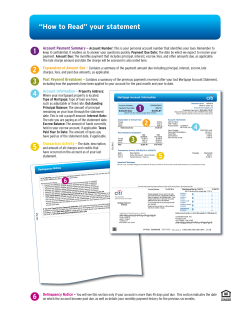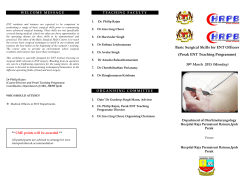
СУЧÐСÐÐÐРФÐÐ¥ÐÐЦЯ - Zhytomyr State University Library
ТРАНСФОРМАЦІЯ МОВНОГО ОБРАЗУ С У Ч А С Н О ГО Ф А Х ІВЦ Я Збірник матеріалів М іжнародної науково-практичної студентської конф еренції М іністерство освіти і науки У країни Ж итом ирський держ авний університет імені Івана Ф ранка Н авчально-науковий інститут іноземної філології К аф едра інозем них мов і новітніх технологій навчання Барановичський держ авний університет (Білорусь) А кадемія «Ігнатіанум» у Кракові (П ольщ а) Istanbul Sabahattin Zaim U niversity (Турція) Т ом ський політехнічний університет Інститут ф ізики високих технологій (Росія) У м анський держ авний педагогічний університет імені П авла Тичини Ф акультет іноземної ф ілології Ж итом ирський держ авний технологічний університет Ж итом ирський інститут м едсестринства Трансформація мовного образу сучасного фахівця Збірник матеріалів М іж народної науково-практичної студентської конференції 15 квітня 2015 року Ж итомир Вид-во Ж Д У ім І. Ф ранка 2015 УДК 811.11.13 НІЖ 81.2 Т 65 Рекомендовано до друку Вченою радою Житомирського державного університету імені Івана Франка протокол N° 8 від 27 березня 2015 року Рецензенти: ІІолховська М.В. - кандидат ф ілологічних наук, доцент, завідувач кафедри англійської ф ілології та перекладу Ж итом ирського держ авного університету імені Івана Ф ранка; Могельницька Л.Ф. - кандидат філологічних наук, доцент, завідувач кафедри інозем них мов Ж итомирського державного технологічного університету; Маліновський Е,Ф. - кандидат філологічних наук, доцент, завідувач кафедри іноземних мов Ж итомирського національного агроекологічного університету. Т 65 Трансформація мовного образу сучасного фахівця: збірник матеріалів М іжнародної науково-практичної конференції для студентів немовних спеціальностей: Житомир, 15 квітня 2015 р./ за заг. ред. Н.М. А ндрш чук Ж итомир : Вид-во Ж Д У їм. І. Ф ранка, 2015. - 2 0 0 с. У збірнику представлені матеріали Міжнародної науковопрактичної студентської конференції «Трансформація мовного образу сучасного фахівця» дзя студентів немовних спеціальностей, що висвітлюють питання філології, психології, педагогіки, історії, екології, інформатики, менеджменту, економіки та медицини. Для студентів вищих навчальних закладів, аспірантів, наукових та педагогічних працівників. УДК 811.11.13 ББК 81.2 Матеріали друкуються в авторській редакції. За достовірність фактів, цитат, власних імен, посилань на літературні джерела та інии відомості відповідають автори публікацій. Думка редакції може не збігатися з думкою авторів. ЗМІСТ 0 . Alekseytschuk. Innovationsm arketing...................................................8 S. Bahinskii. Stohastic m ethod o f calculating the num ber "e".........10 V. Bila. Form ing leadership skills at m asters o f n u rsin g ..................... 12 B. Bojko. Funktionen im topologischen R au m .......................................13 M. Chayka. M odification o f a surface o f m agnetite by hydrox y ap atite................................................................................................15 1. Chukhriy. T he im portance o f com m unicative com petence in professional developm ent............................................................................17 M. Duhovenko. A pplication o f sym m etric polynom ials...................... 19 B. Dumansky. D enarii as the m eans o f propaganda o f the official politics in Rom an E m pire........................................................................... 22 F. Fonaryov. T he history o f U krainian Cinem a B irth ......................... 24 A. Galich. Correction o f interaction in the teacher-student system by m eans o f transactional a n aly sis :............................................. 26 I. Gavrylovskiy. Petro K onashevych-Sagaidachniy and his m ilitary and political a c tiv ity .....................................................................................28 M. Gorban. D er Paratext in W erken von T. G. S chew tschenko.......30 O. Gulinska. T he way to success............................................................ 34 N. Guralchuck. The m ajor them es in E. A. P o e’s “Berenice” ...........36 O. Havrilovskii. C om parative characteristics o f educational platform s M O O D LE and C od ecad em y ...................................................38 O. Holowenko. Pyroelektrischer E ffek t................................................ 40 F. Hrynchuk. C hanges in cytokine status under conditions o f inflam m ation in the peritoneal ca v ity ...................................................... 42 J. Khmilevska. Children rights protection as a social and educational p ro b le m ....................................................... 44 J. Khomutovska. The econom ic developm ent o f Czech Republic and S lo v ak ia...................................................................................................46 D. Khoyda. Em pathy as condition of developm ent of asserveteiveness in teenage p e rio d ........................................................... 48 J. Kodrianu. Form ing moral and ethical norm s at future nurses......... 50 3 <). Kovalchuk Principles o f Japanese m odel o f labour potential and human resource m anagem ent form ation..........................................51 () Kowtunowytsch. Der Einfluss der K om m unikationsum gebung a u f die km dliche E ntw icklung................................................................... 54 /,. Kozachevska. C ode-sw itching as a m arker o f bilm guaism ............56 /'. Kravets. Values o f nature in the education o f teen ag ers................ 58 V. Kukhlyuk. A ndroid developm ent.......................................................... 59 I). Kulimkiy. Alexander M acedonian as a great military leader......... 63 /,. Kyharska. Public and scientific research o f Stepan T om aszew skiy...............................................................................................66 Levchuk. Foreign experience o f professional personnel training and its application in U kraine.................................................................... 69 N. I.ytvynenko. T he expression o f indefiniteness category in the English language o f X IV -X V II centuries................................................71 (). Mad.yud.ya. Functional and information-structural characteristics o f elliptical constructions in XIV-XVII cen. English............................. 73 A. Maha lets Icy. T he Cossack s a b re ........................................................... 75 Y. Maidanovich. The m athem atical p arad o x ..........................................78 V. Maksimenko, O. Klimenko. The preschool teachers’ non-verbal interaction ability.......................................................................................... 80 A. Mankovskiy. B uilding w eb applications for w ork autom ation at the recruitm en agency.................................................................................. 82 /. Markivska. Im pact o f m edical nurse on prevention from com puter addiction in adolescence........................................................... 84 N. Martyniuk. Interrelations betw een a nurse and a p a tie n t............... 88 A. Martynovetz. N urse’s role in palliative and hospice care to incurable patients.......................................................................................... 89 L. Masan. The problem o f morality in Stendhal's novel “ Red and Black” .............................................................................................................. 90 K. Masiuk, A. Momot, Y. Mysenko. Functions o f pedagogical com m unication o f a preschool tea c h e r.................................................... 91 A. Maluh. Sim ilarity as m etric transform ations in Euclidean geom etry ......................................................................................................... 93 4 S. Mazur. The im portance o f teacher’s language at the physical education lesso n s.......................................................................................... 95 J. Morgan. Die Presse in D e u tsc h la n d ....................................................97 T. Moshon. Softw are developm ent for A n d ro id ....................................99 A. Muravska. History o f creation and developm ent o f «Literary Scientific Herald» («L iteratum o-N aukovyi V istn y k»).....................101 G. Osadcha. Cultural and educational developm ent o f M alyn district in X X c e n tu ry ................................................................................ 104 O. Osetska. C om m unitations in the m arketing system ....................106 T. Osmono va. M anagem ent stra té g iq u e ................................................108 O. Overchuk. A nalysis o f creating b lo g s ...........................................110 B. Papizhuk. M ultim edia electronic te x tb o o k ..................................... 113 A. Pavlina. D ie Problèm e der Planung von V erkehrsnetzen 115 Y. Plotnitskiy. Problem o f m ethods testing program system s in IT s e c to r ............................................................................................................. 116 0 . Poida. Arthur Conan D oyle as the originator o f the updated detective g e n re ............................................................................................. 119 1. Polischuk. D iophantine eq u atio n s.......................................................121 A. Polishchuk. M ethods o f solving som e system s o f equations........ 123 V. Polishchuk. U sing C loud com puting in ed u cation........................ 125 O. Poltko. The developm ent o f athletics in Z hytom yr region: historical a s p e c t.................. :...................................................................... 127 D. Pryshchepa. A pplication o f gam e-theoretic approach to decision m aking under risk ....................................................................... 130 E. Razhiyeva. Historical research o f Scycythian m ounds................. 133 M. Rudenko. Peculiarities o f form ing the second foreign language lexical co m p e te n c e .....................................................................................136 P. Sai. M odification o f ohm ic contacts to N -inn by rapid thermal annealing........................................................................................................138 R. Semeniuk. R obotics for b eg in n ers......................................................140 A. Shelestyuk. Tolerance internet users in condition o f w ar ag g re ssio n ..................................................................................................... 141 T. Shmatyuk. T he concept o f the binary t r e e ...................................... 144 5 A. Shuhan. Harrington Em erson’s twelve principles o f efficiency .. 146 (). Sidorowa. Technologien der Erstellung von W ebseiten für die D istanzbildung.............................................................................................148 A. Singayevska. Self-m anagem ent as condition o f personal and professional success....................................................................................150 A. Sinovets. G olden ratio and its ap p licatio n ....................................... 152 I. Siryk. The essence and m eaning o f the Fibonacci n u m b e rs 154 K. Skrytska. Psychologische Bedienungen der Internetabhängigkeit bei den Ju g en d lich en ................................................................................. 157 V. Smolyar. T he analysis o f the m ood in Edgar Allan P o e’s “T he ( ’ask o f A m ontillado” ................................................................................ 160 V. Svintsitskiy. T he m arketing e ffe c t..................................................... 163 M. Svyrydenko. Quality assurance en g in eerin g ...................................165 V. Svyrydiuk. Prospective approaches to form ing communicative com petence o f m aster’s degree students in n u rsin g ............................. 166 A. Synytsya. M ass m ed ia as a factor o f personality socialization 167 K. Tereschuk. Inform ation-structural capacity o f English adverbs even and only in diachrony i ........................................................... 169 I). Tkachuk. T he military activity o f H etm an Petro K onashevichS ahaydachny .....................................................................................171 N. Troiska. Ukrainisch-deutsche Beziehungen von 1991 bis 2014.. 173 Y Tsariova. Epoch tendencies reflection in Ernest Hem ingway w o rk s ....................................................................................................... 176 K. Tsymbalyuk. B ulava in U k rain e......................................................... 177 Tymchuk. Interim -M anager als A ushilfsstellung für gualifizierte Lösung des P roblem s................................................................................. 179 O. llsatiuk. W hy is English difficult to learn for U k rain ia n s 181 A. Varusha. Training future specialists in the system o f multilevel pedagogical education in Ukraine: the historical aspect....................183 /,. Voitsitska. Effect o f nickel sulfate w ater environm ent on indicators o f breathing o f horny planorbarius corneus (m ollusca, gastropoda, pulm onata, bulinidae) in nornal conditions and trem atodes by infestioned......................................................................... 185 6 J. Wonsowytsch. Die Bildungseinrichtungen-der Sozialisierungsfaktor der P ersönlichkeit....................................................................................... 187 0 . Yacenko. C lassification o f w eb-sites and their d esig n................. 189 Y. Yatskevych. T he species com position o f peritrichous infusoria (ciliophora, peritrichia) T eteriv riv e r ................................................191 1. Zagara. Form ation o f m aster students’ skills to w rite a text sum m ary in E n g lish ....................................................................................193 O. Zaharchenko. N u rse’s role in form ing positive attitude tow ards people w ith special needs in U k ra in e .................................................... 195 V. Zakharchuk. M arina T svetaeva’s life and w o rk ........................... 196 V. Zhepko. N u rse’s role in prevention o f m am m ary glands’ benign neoplasm ap p earin g....................................................................................198 7 Y. V. Plotnitskiy Research supervisor: S.S.Zhukovskiy, candidate o f pedagogical science, docent I.Franko Zhytomyr State University Faculty o f Informatics and Applied Mathematics Language tutor: Kravets O.E., candidate o f pedagogical science PROBLEM OF METHODS TESTING PROGRAM SYSTEMS IN IT SECTOR The concept o f word "test" in the English language is used to describe term s which are different in meaning and content: test meter, research, analysis, test operations etc [7, c. 727]. Analysis o f the concept o f word "testing" shows that this concept in English is also used to denote the abovem entioned terms. In the Ukrainian language, the term "test" is considered as a phenomenon, and term "testing" - as a process. 116 Hence the dualism o f concepts appears which raises the question w hether the concept which means a phenom enon can be simultaneously defined as a process and vice versa? In this way, inadequate translation o f concepts leads to misunderstanding o f the nature and purpose of testing as one o f the procedures used in the IT industry. Standard ANSI / IEEE Std. 610.12 defines testing broadly as any activity o f analysis o f different programs (static and dynamic testing) [8]. Testing is closely related to such concepts as "error", "defect", "failure", "problem ", "anomaly" to determ ine w hich there still exist differences in literature. These concepts are differently defined not only in the scientific literature o f the quality and reliability o f software system s, but also in the standards. In particular, the standard A N SI / IEEE-729-83 gives tw o definitions o f th e concept o f failure: 1) failure is the inability o f com puter system or com ponent to perform required functions w ithin the specified limits; 2) failure is a deviation o f the program from its functioning, defined by the requirem ents to the program [9] D uring its im provem ent, the engineering o f testing has been developed in parallel in several ways: research and developm ent o f test m ethods and criteria o f testing adequacy (according to m ethods); determ ination o f m etric testing and criteria o f its com pletion ; creation o f softw are testing tools; form ation o f evaluation m odels o f the testing process[2]. Testing lies in a dynamic checking o f the program for the behavior o f finite set o f test data, specially selected from the input o f infinite space, which should comply with the expected behavior[3]. Dynamic testing always leads to the program execution. Such concepts as "finite test" provides a theoretical possibility to create a number o f tests that do need a lot o f time. Incompleteness is a major problem in testing, because in practice the full set o f tests can be considered as infinite. Number o f tests that can be performed in a limited time, is finite. Thus, the test always involves some "compromise" between a limited period and potentially 117 unlimited number o f tests This leads to the well-known problems o f testing, such as decisions about the adequacy o f testing, and management issues related to estimated costs for testing. The test methods related to the issue o f adequacy o f testing and selection o f a limited set o f tests are called selected. These testing methods, in general, differ in their approaches to the selection o f the set o f test data from the input space. The inability o f exhaustive testing has led to the developm ent o f the scientific literature o f different techniques to reduce the set o f tests and to the search for criteria o f test adequacy [4]. The traditional classification methods is based on testing division into two categories - the "black box" (functional) and "white box" (structural) [2, 6] and considers two approaches to the design o f tests. M odem classification o f test methods is based on the approaches to designing tests. Selection o f the most effective methods o f testing under certain conditions and at different levels o f testing is a complex problem and is associated with the analysis o f risks o f software systems failures. LITERATURE 1. 2. 3. 4. 5 А нгло-український словник: У 2 т, - Близько 120000 слів / Склав М.І. Балла. - К.: Освіта, 1996. - Т.2. - 712 с. Бабенко JI. П. О снови програмної інженерії: Навчальний посібник для вузів / Л ю дмила П етрівна Бабенко, К атерина М ихайлівна Лавріщ ева. - Київ: Знання, 2001 . - 269 с Канер С., Ф олк Д., Нгуен Е.К. Тестирование программного обеспечения: Пер с англ - К : DiaSoft. - 2000. - 544 с. Коваль Г. И., Коротун Т. М ., Слабоспицкая О. О. Соверш енствование процесса тестирования программного обеспечения компью терных систем: М етодика. - Киев: ИПС Н АН Украины. - 2003. - 81с. Кривонос О М Використання методик екстремального програмування в підготовці майбутніх вчителів інформатики / Кривонос О М. // Нові інформаційні технології в освіті для всі ГТЕА - 2014. Збірник праць Д ев’ятої М іжнародної конференції 26 листопада 2014 року Київ.Частина 1. С.269274. 118 6. 7. 8. 9. Л аврищ ева Е М , Коротун Г М . П остроение процесса тестирования программны х систем // П роблемы программирования. -2002. - № 1-2. - С. 272-281. Ш апиро У. Русско-английский, англо-русский словарь: более 32000 слов / П од общей редакцией У.Т. М аклеонда. И здательство Н аука-У айли, 1992. - 982 с. IEEE Std. 610.12:1990. IEEE Standard Glossary o f Softw are E ngineering T erm inology. AN SEIEEE Std 729-1983. Толковы й словарь терминологии, используемой при разработке П О // IEEE, N ew -Y ork, 1983, 30 р 119 Н аукове видання Трансформація мовного образу сучасного фахівця Збірник матеріалів М іж народної науково-практичної студентської конференції 15 квітня 2015 року Надруковано з оригінал-макета авторів Підписано до друку 02.04.15. Формат60x90/16. Папір офсетний. Гарнітура Times New Roman. Друк різографічний. _______ Ум. друк, арк. 11,6. Обл. вид арк. 8,6 Наклад 100. Зам. 38.________ Видавництво Житомирського державного університету шсні Івана Франка м. Житомир, вул. Велика Бердичівська, 40 Свідоцтво про державну реєстрацію: серія ЖТ №10 в ід 07.12.04 р. електронна пошта (E-mail): zu@zu.edu.ua
© Copyright 2025















